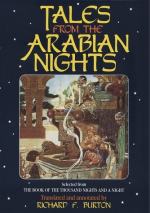2. The Story of Monia Em n corresponds to the Story of Naerdan and Guzulbec, in Caylus’ Oriental Tales. A story of magical illusions.
3. The Story of Ferah N z.—Here again we have a variant of Nos. 9a and 152.
3a. Khoja ’Abdu-ltab.—This is a version of the Story of Aboulcassem in the Thousand and One Days.
4a. Sh b r and Hum .—The commencement of this story might have suggested to Southey the adventures of Thalaba and Oneida in the Gardens of Aloadin; the remainder appears to be taken from the Story of the young King of Thibet, in the Thousand and One Days.
5. Qara Khan.—The principal part of this story is borrowed from the First Voyage of Aboulfawaris in the Thousand and One Days; it has some resemblance to the story of the Mountain of Loadstone in No. 3c.
7. FRUeCHTE des ASIATISCHEN Geist, von A. T. Hartmann. 2 vols., 12mo (Muenster) 1803. A collection of anecdotes, &c., from various Eastern sources, Arabic, Indian, &c. I think it not impossible that this may be the work referred to by Von Hammer in the preface to Zinserling’s “1001 Nacht” (p. xxvii. note) as “Asiatische Perleuschnur von Hartmann.” At least I have not yet met with any work to which the scanty indication would apply better.
8. Tuti-Nama. I could hardly pass over the famous Persian and Turkish “Parrot-Book” quite without notice; but its tales have rarely any direct connection with those in The Nights, and I have not attempted to go into its very extensive bibliography.
DR. CLARKE’S M.S.
Dr. Edward Daniel Clarke has given an account of an important Ms. nearly agreeing with Bul. and Mac., which he purchased in Egypt, in his “Travels in various countries of Europe, Asia and Africa.” Part ii. Greece, Egypt, and the Holy Land. Section i. (1812) App. iii., pp. 701-704. Unfortunately, this Ms. was afterwards so damaged by water during a shipwreck that it was rendered totally illegible. The list of tales (as will be seen by the numbers in brackets, which correspond to our Table, as far as the identifications are safe) will show the approximate contents of the Ms., but the list (which is translated into German by Habicht in the preface to his vol. 12) was evidently compiled carelessly by a person nearly ignorant of Arabic, perhaps with the aid of an interpreter, Maltese, or other, and seems to abound with the most absurd mistakes. The full text of Clarke’s App. iii. is as follows: “List of One Hundred and Seventy-two Tales, contained in a manuscript copy of the ‘Alif Lila va Lilin,’ or ’Arabian Nights,’ as it was procured by the Author in Egypt.”
N.B.—The Arabic words mentioned in this list are given as they appeared to be pronounced in English characters, and of course, therefore, adapted to English pronunciation.




